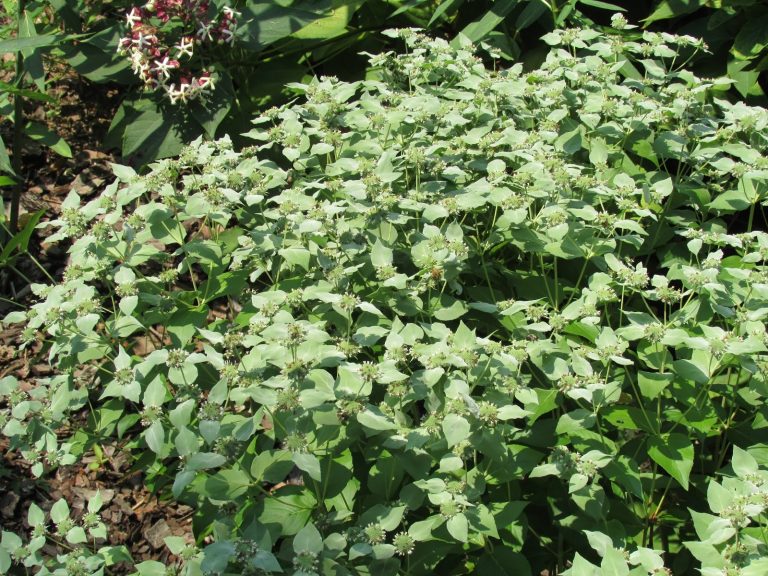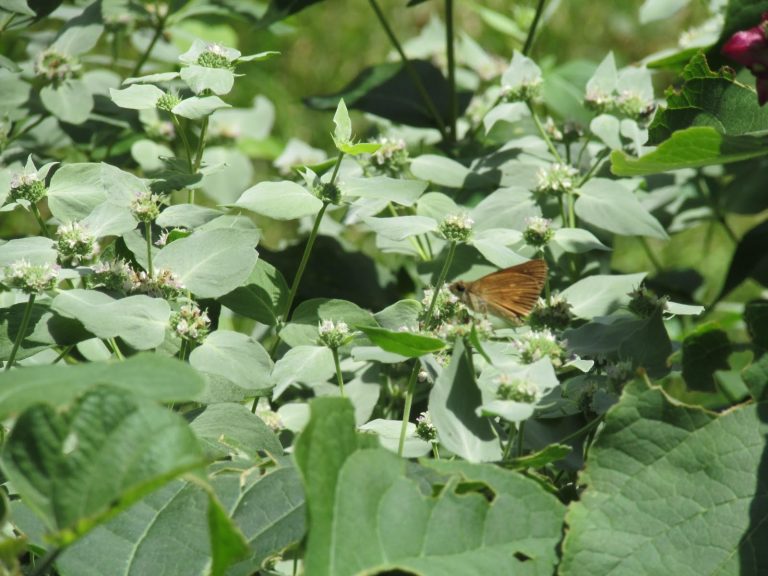Many native plants are not widely known and therefore underused. The big box stores don’t carry them, so gardeners are unaware of them. However, they are stellar performers in the garden. Such is the case with mountain mint, a versatile native with tiny, tubular flowers that attract pollinators like there’s no tomorrow. When in bloom from about July to September, this plant will probably be the top pollinator plant in your garden, feeding all kinds of beneficials from syrphid flies to bees and small butterflies.

The flowers of this plant are white with flashes of pink and lavender, but are almost insignificant except for the scores of insects that feed on them. The number and diversity of pollinators attracted to mountain mint are astounding. There are always winged wonders buzzing over it, and I am fascinated by insects I’ve never seen before, including many wearing metallic coats of armor.
The leaves are dark green but the top of the plant sports leaf-like bracts that are silvery and appear to have a dusting of snow. It is these silvery bracts that really make the plant attractive and give it the appearance of being in bloom for even longer. In addition, silver goes with almost anything in the garden so one doesn’t have to worry about clashing colors! It’s the little black dress of the plant world. The plant is known by several monikers including blunt mountain mint, short-toothed mountain mint, and clustered mountain mint, so search for it by its scientific name, Pyncnanthemum muticum, to avoid confusion.
Mountain mint grows in full sun to partial shade but is better in full sun. It is native to eastern North America from Maine to Florida and west to Texas and Michigan. Reaching about 3 feet tall in average-to-moist soils, it does tolerate drought. I have heard it can be used to shade out Japanese stiltgrass in sunny areas. Unlike some floppy perennials, its sturdy stems stay erect in the garden.
It is a mint and can spread by rhizomes, but don’t discount it because of its familial relations. Clump-forming and only moderately aggressive, it can be easily pulled out. The plant is strongly aromatic when crushed. I’ve read that decades-old museum specimens are still fragrant. Although references tend to describe it as a fresh minty fragrance, I find its strong aroma unpleasant, more like gasoline than mint. And it is deer resistant. If the deer ever start eating this plant it’s time to throw in the towel.
Mountain mint can be found in Laurelwood’s sensory garden. Just look for the silvery plant with all the insects hovering above it. Use it in your garden, and you’ll get to admire its many visitors!
To see just how many pollinators mountain mint attracts,
Visit Native Plant Channel on YouTube and Facebook.

